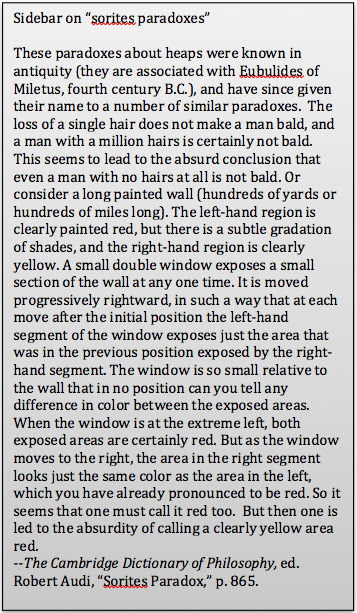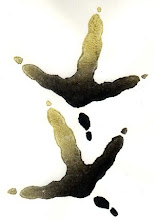In a recent article, “Canned
Hunting: Don’t Call It Hunting!” outdoor writer David Petersen discusses
the difference between fair chase and canned hunts, and he quotes Orion founder
Jim Posewitz approvingly.
“A fenced shoot,” Posewitz writes, “is
just the sale of a fabricated image to people who have neither the skill nor
the inclination to obtain the real thing.”
Petersen agrees, and argues, “There is honorable
hunting, and there is cowardly captive killing. The motivations and characters
defining each are as distinct as day and night.”
Petersen is wrong. The motivations and character of hunters are
NOT as distinct as day and night. There
is no distinct line between canned hunts on the one hand, and fair chase on the
other.
The difference between honorable
hunting and cowardly hunting does not depend on the presence or absence of a
fence. Ideals of honor and cowardice,
however, as well as ideals of fair chase, depend crucially on the hunter, and
upon the hunter’s skills and aptitude.
Fair chase has traditionally been defined relative to the animal—in
particular, to the animal’s ability to escape.
What’s missing in most debates about fair chase is the
awareness that we need also to define fair chase relative to the human hunter—and
to be specific, to the individual hunter’s ability to hunt. (And here we also know
that hunters come in all shapes, sizes, interests, and abilities.)
Furthermore, we must acknowledge that there is a fundamental
ambiguity to the very concept of fair chase. This ambiguity involves the philosophical
problem of vagueness, a problem that has long been identified by philosophers
as the sorites paradox, from the
Greek term meaning “heap” or “pile.”
The paradox is this:
start with a pile of sand, and begin removing the sand, one grain at a
time. At what point does the pile or
heap become a “non-heap”?
The thought experiment can also be run in reverse: start
with a grain of sand, and add to it another grain of sand. Do you now have a
pile of sand? Of course not. Now add a third grain. Is it a heap yet? Of course not. Now, continue adding sand, one grain at a
time . . . at what point do you have a
heap of sand?
The upshot is that there is no clear dividing line between having one or two grains of sand
(that might constitute the concept dust) and having a pile, or a heap, or even
a mountain of sand. Thus the very
concept of heap or pile or mountain is ambiguous.
Baldness
is another inherently ambiguous concept (my own baldness, however, is
clearly unambiguous). Begin with a full head of hair and remove it one
hair at a time. When do you cross the line from having hair to being
bald? (For me, it was around the age of 20!)
 |
| Author Jim Tantillo |
Trying to define fair chase is exactly like this—like trying
to define “baldness” or “pile.”
So what does all this have to do with hunting?
On the one hand, or to be more precise, on one end of the
spectrum (and spectrum, a term from
physics, is exactly the right term to use) we have hunting practices that are
clearly akin to a single grain of sand or to my gloriously bald pate.
To illustrate the point: imagine a deer chained to a post in a 10’x10’ chain-link enclosed pen, being shot at close range. Clearly this is not fair chase: the deer has no ability to avoid death, and the hunter needs no ability at such close range either to pursue or to shoot the tethered animal.
Remove the tether.
Now the deer is in a 10 x 10 enclosure, but can move around. Is this fair chase? Clearly the hunter is at more of a disadvantage
than in the first scenario: the deer may jump at precisely the same moment as
he/she squeezes the trigger, and the hunter may wound the animal or possibly
even miss entirely. It may take two
shots to bring the animal down, particularly for a poor marksman.
Does this second scenario constitute fair chase? Clearly not, the animal is still enclosed,
and little to no skill is needed on the part of the hunter.
Let us now imagine that we expand the enclosure—how about a
full acre? And while we are at it, let’s
add an acre’s worth of brushy vegetation.
The deer has the ability to roam about, but the hunter must still stay
out of the fence to shoot the animal.
All the hunter need do in this case, is wait patiently for
the deer to come along within view inside the fence, and take a killing shot.
Is this fair chase?
Probably not, although now the lines are getting a little more
fuzzy. How does waiting outside the
fence differ from an archer sitting and waiting in a tree stand? But I’ll leave that question for another
essay.
Let’s keep going, trying to get closer to fair chase. Let’s put a gate in the fence, and allow the
hunter to enter and pursue the animal within the one-acre confines of the
enclosure. The animal can still move
around and has plenty of early-successional shrubland (let’s go ahead and fill
the enclosure with thorny multiflora rose and honeysuckle) in which to hide.
Now it takes the hunter the better part of a morning to
locate, stalk, and shoot the deer. But
after several hours of patient stalking, the hunter is successful.
Does this “hunt” now constitute “fair chase”? Observe that we have come a fair way from
shooting the animal that was tethered inside what was essentially a dog
pen.
Most
hunters still would not be comfortable labeling the one-acre stalk on a
deer--multiflora rose or not--as a fair chase hunt. And yet notice
that some hunters might . . . . We can imagine hunters with
disabilities, for example, who might be content with such a one-acre
stalk if confined to a wheel chair. Or a young hunter, just starting
out, may appreciate and learn from such an experience.
Note that I am not implying that this necessarily would be a
good hunt, for young hunters or hunters
with disabilities. I am simply
suggesting that the hunt might provide sufficient challenge to each individual
hunter, and each hunter might possibly go home satisfied with their hunting
experience.
Now let’s continue the sorites part of our thought
experiment. Let’s rerun the thought
experiment a thousand times, adding one additional acre with each
repetition. First the hunter pursues the
deer in a two-acre enclosure, and then in a three-acre enclosure . . . and so
on, and so on, and so on. (And let’s,
for the sake of argument, assume there is only a single, individual deer to be
pursued—not legions of overpopulated deer as occur in many areas of the
country.)
At what point does the enclosure become large enough that we
cross a line between canned hunting and fair chase?
Perhaps never, for some hunters. For them, hunting inside a fence is always
unethical. But for others, trying to
pursue a single deer in a 1,000-acre enclosure, or a 5,000-acre enclosure, or a
20,000-acre enclosure, would be challenging and fair regardless of the
proximity of the fence.
So now let’s just remove the fence. And imagine the same, solitary, single deer
roaming about unrestricted over a 20,000-acre, or 50,000-acre, fenceless
area. Would this hunt now constitute
fair chase?
I’m pretty sure if you plunked down a hard-core deer hunter,
and took away his tree stand, and made him stalk a single deer over 50,000
acres (that’s 78.125 square miles!), he or she would most likely call that a
fair chase hunt.
David Petersen is wrong because he sees
a distinct line where none exists. One
hunter’s canned hunt is another’s fair chase hunt. Questions about the ethics and morality of
“canned hunts” need to be answered on a case-by-case, hunter-by-hunter basis,
not by the types of overly broad generalizations that Petersen offers.
And broad generalizations are exactly
what Petersen offers:
“Canned killing is a
suppurating sore on the face of honorable hunting, an impotent's end game, an
insult to the unfettered wildness that shaped humans and wildlife alike, an
orgy of objectification and utter disregard for the prey, and one more ugly
omen that something is horribly wrong with our unconscionably commercial,
insanely competitive, egregiously egoistic, nature-raping, soul-slaughtering,
profit-driven mother culture.”
Whew! I wish Petersen would tell us
what he really thinks!
Kidding aside, such purist approaches
to hunting may do more harm than good to hunters and hunting in the long
run. In my view, Petersen’s “it’s my
way or the highway” ethic is far more threatening to the future of hunting than
any fenced shoot of animals. What
hunters need to do is respect the differences between hunters: differences in
motivation, differences in skills and aptitude, differences in character.
While I myself might never hunt a
captive animal in a high fence setting, unlike David Petersen I am not about to
tell someone else that they should not do so.
As long as a hunter conscientiously strives for a clean, quick, one-shot
kill, and does so safely while respecting the law, then that hunter acts
ethically and morally.
The difference between canned hunting
and fair chase is like the difference between a grain of sand and a pile of sand. When viewed on each end of the hunting
spectrum, fair chase and canned hunting are clearly different. But there is no distinct line, no clearly
unambiguous boundary, to be drawn between fair chase and canned hunts, or
between honorable hunters and cowards.
____________________________
Jim
Tantillo is the Executive Director of Orion,
The Hunters’ Institute. He has M.S. and Ph.D. degrees from Cornell
University, where he currently also teaches ethics and environmental philosophy
in the Department of Natural Resources.A grouse hunting purist, Jim will generally argue until he is blue in the face that the One, True, Correct Way to Hunt Grouse is with a 16 gauge Parker double gun over the staunch point of a well-trained English setter. In the spirit of political toleration, however, he also argues until he is equally blue in the face that his retriever- and spaniel-owning friends be permitted to hunt grouse legally as they see fit, despite their aesthetically misguided preferences for flushing dogs or 12 gauge autoloaders!










2 comments:
Calling a love struck bull elk to within only a few feet of a would be love hungry fake cow could also be considered unfair chase I guess.
This Petersen guy seems awfully grumpy. Definitely needs a week in a Grouse Camp (...not mine ;-) )w/ some regular folk.
Post a Comment